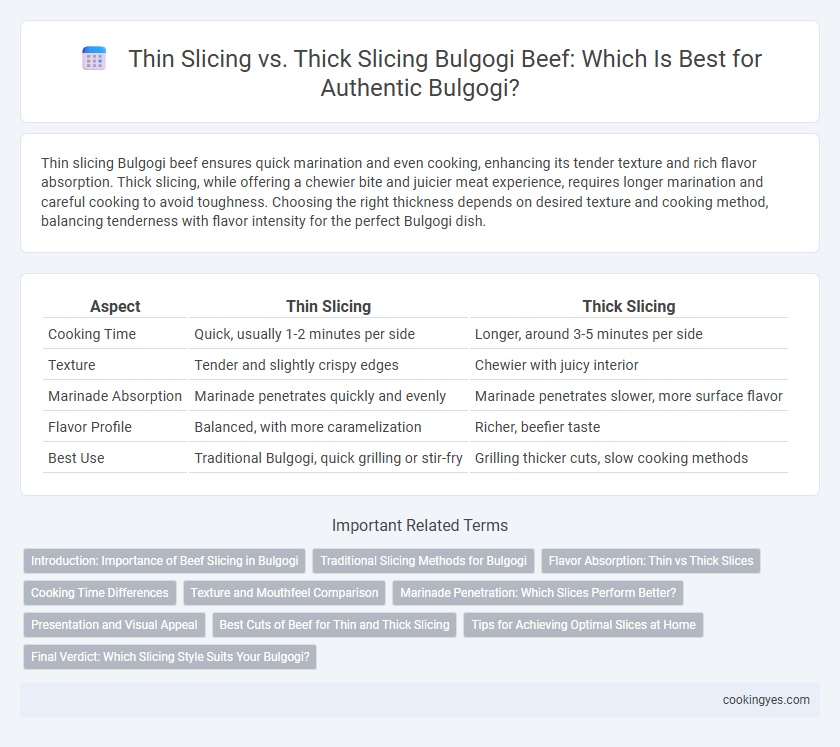Thin slicing Bulgogi beef ensures quick marination and even cooking, enhancing its tender texture and rich flavor absorption. Thick slicing, while offering a chewier bite and juicier meat experience, requires longer marination and careful cooking to avoid toughness. Choosing the right thickness depends on desired texture and cooking method, balancing tenderness with flavor intensity for the perfect Bulgogi dish.
Table of Comparison
| Aspect | Thin Slicing | Thick Slicing |
|---|---|---|
| Cooking Time | Quick, usually 1-2 minutes per side | Longer, around 3-5 minutes per side |
| Texture | Tender and slightly crispy edges | Chewier with juicy interior |
| Marinade Absorption | Marinade penetrates quickly and evenly | Marinade penetrates slower, more surface flavor |
| Flavor Profile | Balanced, with more caramelization | Richer, beefier taste |
| Best Use | Traditional Bulgogi, quick grilling or stir-fry | Grilling thicker cuts, slow cooking methods |
Introduction: Importance of Beef Slicing in Bulgogi
Beef slicing thickness critically impacts Bulgogi's texture and flavor absorption, with thin slices allowing quicker marination and tender cooking, enhancing traditional taste profiles. Thick slices retain juiciness and offer a chewier bite but require longer marination and careful grilling to avoid toughness. Optimal slicing balances beef quality with cooking method to achieve authentic Bulgogi experience.
Traditional Slicing Methods for Bulgogi
Traditional slicing methods for Bulgogi emphasize thin slicing to ensure quick marination and even cooking, enhancing flavor absorption and tenderness. Thin slices, typically 1-2 mm thick, allow the marinade to penetrate deeply, resulting in a soft, juicy texture that is characteristic of authentic Bulgogi. In contrast, thick slicing is less common as it inhibits marinade infiltration and requires longer cooking times, potentially compromising the dish's delicate balance of sweet and savory flavors.
Flavor Absorption: Thin vs Thick Slices
Thin slices of Bulgogi beef absorb marinades more quickly and evenly due to their larger surface area and reduced thickness, resulting in a more intense and well-distributed flavor profile. Thick slices retain juiciness and provide a richer, meatier texture but require longer marination times to penetrate flavors deeply. Choosing between thin and thick slices depends on desired balance between rapid flavor infusion and maintaining succulent, tender bites.
Cooking Time Differences
Thin slicing Bulgogi beef allows for rapid cooking, typically taking just one to two minutes per side, which helps retain tenderness and enhances marinade absorption. In contrast, thick slicing requires longer cooking times, often three to five minutes per side, to ensure even heat penetration and proper caramelization. Optimizing slice thickness balances cooking speed with texture, influencing the overall flavor and juiciness of the Bulgogi.
Texture and Mouthfeel Comparison
Thin slicing Bulgogi beef enhances tenderness and allows quick absorption of marinade, resulting in a delicate, melt-in-the-mouth texture. Thick slicing delivers a chewier, meatier mouthfeel with pronounced beef fibers, offering a heartier bite. The choice between thin and thick slices directly influences the overall eating experience, balancing softness against richness.
Marinade Penetration: Which Slices Perform Better?
Thin slicing Bulgogi beef enhances marinade penetration by increasing surface area, allowing flavors to infuse quickly and evenly. Thick slices require longer marinating times to achieve similar depth of flavor, as the marinade struggles to penetrate the denser meat. For optimal taste and tenderness, thin slices outperform thick cuts in absorbing the rich, savory marinade characteristic of traditional Bulgogi.
Presentation and Visual Appeal
Thin slicing Bulgogi beef enhances visual appeal by creating delicate layers that cook quickly and evenly, resulting in a tender, glossy texture that glistens when served. Thick slicing offers a more robust presentation with pronounced grill marks and a hearty, juicy interior that contrasts visually with caramelized edges. The choice between thin and thick slicing directly affects the dish's aesthetic, balancing subtle elegance against bold, rustic charm.
Best Cuts of Beef for Thin and Thick Slicing
For Bulgogi, thin slicing is ideal for tender cuts like ribeye and sirloin, which cook quickly and absorb marinades effectively, enhancing flavor and texture. Thick slicing suits more robust cuts such as brisket or chuck, offering a chewier bite that holds up well to grilling and adds a hearty dimension to the dish. Selecting the right cut based on slicing thickness ensures optimal tenderness and flavor balance in Bulgogi.
Tips for Achieving Optimal Slices at Home
For authentic Bulgogi, thin slicing beef around 1/8 inch thick ensures quick marination and tender texture, maximizing flavor absorption. Using partially frozen beef stabilizes the meat, allowing for uniform, thin slices with minimal shredding. Employ a sharp, flexible knife and slice against the grain to enhance tenderness and achieve optimal cooking results.
Final Verdict: Which Slicing Style Suits Your Bulgogi?
Thin slicing Bulgogi beef ensures rapid marination and even cooking, yielding tender, flavorful bites perfect for quick grilling. Thick slicing provides a juicier texture and richer mouthfeel, ideal for those who prefer a meatier, more substantial bite. Choose thin slices for traditional, fast-cooked Bulgogi, while thick slices suit a heartier, chew-focused experience.
Thin slicing vs thick slicing for Bulgogi beef Infographic

 cookingyes.com
cookingyes.com